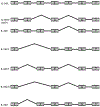Role of MDA-7/IL-24 a Multifunction Protein in Human Diseases
- PMID: 29551126
- PMCID: PMC6218935
- DOI: 10.1016/bs.acr.2018.02.005
Role of MDA-7/IL-24 a Multifunction Protein in Human Diseases
Abstract
Subtraction hybridization identified genes displaying differential expression as metastatic human melanoma cells terminally differentiated and lost tumorigenic properties by treatment with recombinant fibroblast interferon and mezerein. This approach permitted cloning of multiple genes displaying enhanced expression when melanoma cells terminally differentiated, called melanoma differentiation associated (mda) genes. One mda gene, mda-7, has risen to the top of the list based on its relevance to cancer and now inflammation and other pathological states, which based on presence of a secretory sequence, chromosomal location, and an IL-10 signature motif has been named interleukin-24 (MDA-7/IL-24). Discovered in the early 1990s, MDA-7/IL-24 has proven to be a potent, near ubiquitous cancer suppressor gene capable of inducing cancer cell death through apoptosis and toxic autophagy in cancer cells in vitro and in preclinical animal models in vivo. In addition, MDA-7/IL-24 embodied profound anticancer activity in a Phase I/II clinical trial following direct injection with an adenovirus (Ad.mda-7; INGN-241) in tumors in patients with advanced cancers. In multiple independent studies, MDA-7/IL-24 has been implicated in many pathological states involving inflammation and may play a role in inflammatory bowel disease, psoriasis, cardiovascular disease, rheumatoid arthritis, tuberculosis, and viral infection. This review provides an up-to-date review on the multifunctional gene mda-7/IL-24, which may hold potential for the therapy of not only cancer, but also other pathological states.
Keywords: Cancer; Human diseases; Inflammation; MDA-7/IL-24.
© 2018 Elsevier Inc. All rights reserved.
Conflict of interest statement
CONFLICT OF INTEREST
P.B.F. is a cofounder and owns stock in Cancer Targeting Systems (CTS). Virginia Commonwealth University, Johns Hopkins University, and Columbia University own stock in CTS.
Figures




Similar articles
-
Recent insights into apoptosis and toxic autophagy: The roles of MDA-7/IL-24, a multidimensional anti-cancer therapeutic.Semin Cancer Biol. 2020 Nov;66:140-154. doi: 10.1016/j.semcancer.2019.07.013. Epub 2019 Jul 26. Semin Cancer Biol. 2020. PMID: 31356866 Free PMC article. Review.
-
Melanoma differentiation associated gene-7/interleukin-24 (mda-7/IL-24): novel gene therapeutic for metastatic melanoma.Toxicol Appl Pharmacol. 2007 Nov 1;224(3):300-7. doi: 10.1016/j.taap.2006.11.021. Epub 2006 Nov 23. Toxicol Appl Pharmacol. 2007. PMID: 17208263 Free PMC article. Review.
-
mda-7/IL-24: multifunctional cancer-specific apoptosis-inducing cytokine.Pharmacol Ther. 2006 Sep;111(3):596-628. doi: 10.1016/j.pharmthera.2005.11.005. Epub 2006 Feb 7. Pharmacol Ther. 2006. PMID: 16464504 Free PMC article. Review.
-
mda-7/IL-24, a novel cancer selective apoptosis inducing cytokine gene: from the laboratory into the clinic.Cancer Biol Ther. 2003 Jul-Aug;2(4 Suppl 1):S23-37. Cancer Biol Ther. 2003. PMID: 14508078 Review.
-
Genomic structure, chromosomal localization and expression profile of a novel melanoma differentiation associated (mda-7) gene with cancer specific growth suppressing and apoptosis inducing properties.Oncogene. 2001 Oct 25;20(48):7051-63. doi: 10.1038/sj.onc.1204897. Oncogene. 2001. PMID: 11704829
Cited by
-
Oncolytic therapy with vaccinia virus carrying IL-24 for hepatocellular carcinoma.Virol J. 2022 Mar 15;19(1):44. doi: 10.1186/s12985-022-01779-1. Virol J. 2022. PMID: 35292065 Free PMC article.
-
Recent insights into apoptosis and toxic autophagy: The roles of MDA-7/IL-24, a multidimensional anti-cancer therapeutic.Semin Cancer Biol. 2020 Nov;66:140-154. doi: 10.1016/j.semcancer.2019.07.013. Epub 2019 Jul 26. Semin Cancer Biol. 2020. PMID: 31356866 Free PMC article. Review.
-
MDA-9/Syntenin/SDCBP: new insights into a unique multifunctional scaffold protein.Cancer Metastasis Rev. 2020 Sep;39(3):769-781. doi: 10.1007/s10555-020-09886-7. Cancer Metastasis Rev. 2020. PMID: 32410111 Free PMC article. Review.
-
Clinical Significance of the Interleukin 24 mRNA Level in Head and Neck Squamous Cell Carcinoma and Its Subgroups: An In Silico Investigation.J Oncol. 2020 Sep 18;2020:7042025. doi: 10.1155/2020/7042025. eCollection 2020. J Oncol. 2020. PMID: 33014054 Free PMC article.
-
Mechanism of internalization of MDA-7/IL-24 protein and its cognate receptors following ligand-receptor docking.Oncotarget. 2019 Aug 20;10(49):5103-5117. doi: 10.18632/oncotarget.27150. eCollection 2019 Aug 20. Oncotarget. 2019. PMID: 31489119 Free PMC article.
References
-
- Allen M, Pratscher B, Krepler C, Frei K, Schofer C, Pehamberger H, et al. (2005). Alternative splicing of IL-24 in melanocytes by deletion of exons 3 and 5. International Journal of Immunogenetics, 32, 375–378. - PubMed
-
- Allen M, Pratscher B, Roka F, Krepler C, Wacheck V, Schofer C, et al. (2004). Loss of novel mda-7 splice variant (mda-7s) expression is associated with metastatic melanoma. The Journal of Investigative Dermatology, 123, 583–588. - PubMed
-
- Andoh A, Shioya M, Nishida A, Bamba S, Tsujikawa T, Kim-Mitsuyama S, et al. (2009). Expression of IL-24, an activator of the JAK1/STAT3/SOCS3 cascade, is enhanced in inflammatory bowel disease. Journal of Immunology, 183, 687–695. - PubMed
-
- Azab B, Dash R, Das SK, Bhutia SK, Shen XN, Quinn BA, et al. (2012).Enhanced delivery of mda-7/IL-24 using a serotype chimeric adenovirus (Ad.5/3) in combination with the apogossypol derivative BI-97C1 (Sabutoclax) improves therapeutic efficacy in low CAR colorectal cancer cells. Journal of Cellular Physiology, 227, 2145–2153. - PMC - PubMed
Publication types
MeSH terms
Substances
Grants and funding
LinkOut - more resources
Full Text Sources
Other Literature Sources
Medical

